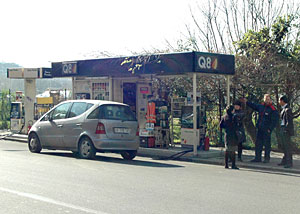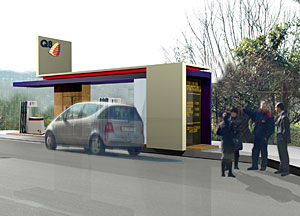Rome’s tiny gas stations will soon pump a lot more than petroleum into the city’s transportation system. The Unione Petrolifica, an organization representing the interests of oil companies including Erg, Agip, and Total, has turned to local architects Marco Bevilaqua and Bianca Patroni-Griffi to transform the approximately 30 pit stops into centers that dispense bus tickets, listings and tickets for nearby cultural events, snacks—and, yes, gas.



The union of gas station owners in Rome is rebuilding these tiny pit stops, many of which were hastily constructed in the 1970s (top). Architects Marco Bevilaqua and Bianca Patroni-Griffi have been commissioned to design a new standardized station (middle). The new station’s design contains information displays (above). The stations can be customized to blend in with the character of different neighborhoods, like this one planned for the Piazza dell'Esquilino (right).
The high concentration of gas stations on premium real estate is a problem unique to Rome. Built hastily and with ambiguous legality during the country’s rush of sudden wealth and traffic in the 1970s, their design was meant to downplay any interference with urban infrastructure. They are little more than pit stops into which motorists swerve, re-fuel, and exit right back into traffic: open areas defined by a pumps and erratically placed advertising in the narrow space between street and sidewalk.
The location and footprint of existing stations will remain intact, but their structure and function is being brought up to speed. Bevilacqua and Patroni-Griffi have designed a uniform system of stations outfitted with vending machines and LED screens that display traffic conditions and information about cultural events. Rather than catering just to motorists, Bevilacqua says, the new units will “give modern urban citizens access to the city’s entire transportation network.”
Each new center represents an amalgam of three components: a base, a main section supplying the streetside wall and protective overhang, and a pedestrian-side support wall. An LED screen will be sandwiched between the two walls. The size and shape of individual components will vary to accommodate site restrictions, such as trees and lampposts.
Although most centers will be fabricated in the custom colors of each gas company, some of the building materials will make special reference to Rome’s natural landscape and imperial past. Travertine, used in the base, is a sedimentary rock from nearby Tivoli that ancient builders used to clad the Coliseum and other structures. Stations close to these ancient monuments—and therefore subject to strict zoning laws—will sport a middle section made of copper, like many statues throughout the city, or lead, like the cupolas of most Roman churches.
The first 10 centers will be erected by Archigia, the construction company that builds most of Italy’s gas stations, in early 2008. Each costs roughly $53,400 and takes one month to assemble.




Post a comment to this article
Report Abusive Comment